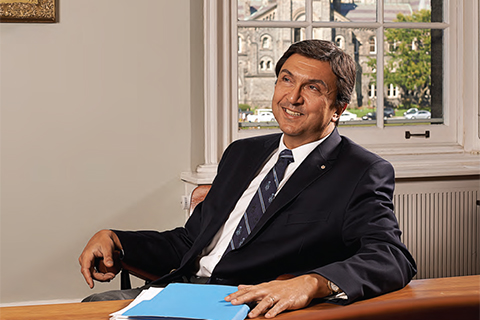These are sunny days in Canada. Our dollar is at parity with the American greenback, our economy is strong and our inclusive society draws talented immigrants from around the world. But clouds are appearing on the horizon. Recently, the Conference Board of Canada ranked Canada’s performance in innovation a lowly 14th out of 17 comparator countries in the Organisation for Economic Co-operation and Development (OECD). Our rate of private-sector investment in research and development has been declining since 2001. The latest data show that Canada files patents at just 58 per cent of the OECD average rate.
We also fare poorly on comparisons of how we prepare our citizens for the global knowledge economy. Although Canadians are more likely than citizens of other OECD countries to attend community college, we are strikingly less likely to attend graduate school. Twenty years ago, Canadian universities received $2,000 per student more from governments than their American peers. Today, they receive, on average, $5,000 less. In publications per professor, one measure of research productivity, Canada ranks fourth in the OECD, ahead of the U.S. and Japan. But among individual North American institutions, Harvard University still leads the way by a big margin; California’s public universities – UCLA, UC Berkeley – also fare very well.
How do the Californians do it? By deliberately and strategically concentrating graduate education at the 10 University of California campuses. Professors at these institutions have won 50 Nobel prizes – 18 since 1995. Canada, in contrast, exports many potential Nobel Prize winners and sometimes imports winners from elsewhere, but rarely grows and keeps its own Nobel laureates. The last three were U of T’s John Polanyi in 1986, UBC’s Michael Smith in 1993 and, in 1994, Bertram Brockhouse – a scientist affiliated with McMaster University.
There are no quick fixes for our current malaise, but five policy shifts might boost our innovation capacity. First, governments should fund basic research more generously. From lasers to Teflon, countless economically important advances have piggybacked on basic research. And in regions where Nobel Prize winners congregate in great universities, knowledge-based industries flourish in a wonderfully synergistic relationship.
Second, governments need to simplify the mandates of research agencies. Today’s research agencies – especially our three national granting councils – are too often asked to promote commercialization or oversee networks with industry. These expansive mandates dilute scarce resources and distract top talent.
Third, Canadians are efficient at turning dollars into research but inefficient at turning research into dollars. Commercialization is not the enemy of fundamental research; nor is the converse true. However, it is wrong headed to insist that granting councils and research agencies constantly look downstream to the marketplace when their sights are justifiably set upstream on knowledge generation. Instead, we need dedicated commercialization agencies and infrastructure.
Fourth, Canada’s research universities actually lose money with most grants their professors receive. With each grant, the institution takes on new costs for maintaining labs, heating and lighting buildings and providing support services to researchers. That’s why the British government pays an extra 48 cents per dollar of grant payment, while American coverage averages 60 cents on the dollar. In Canada, federal grants cover these critical costs at a rate that is inversely proportional to the total research activity at an institution. Think of it as Orwell without the irony.
Finally, we urgently need more master’s and PhD graduates to spur growth in our knowledge-based industries. But we can’t achieve the necessary expansion in graduate education without a serious rethinking of how we organize and fund our institutions of higher education. Canada needs graduate-intensive universities with the research resources to compete internationally. At the same time we need well-funded undergraduate-intensive universities educating a talented global citizenry. Other jurisdictions such as California have long since recognized that distinct institutions perform these roles best.
Everyone knows that India and China are rising fast. But Europeans, too, are forging new economic and educational alliances with each other. And our giant neighbour to the south will almost certainly reinvent itself to remain a global force. Canada cannot simply do more – or less – of the same in this changing context. We must embrace the spiky topography of excellence and innovation if future generations of Canadians are to thrive.
Sincerely,
DAVID NAYLOR







No Responses to “ The Topography of Innovation ”
President Naylor responds:
U of T is proud of alumni such as Mike Szarka who contribute to postsecondary institutions in Canada and around the world.
Mr. Szarka’s letter suggests that I advocate a simple two-tiered system of higher education with undergraduate-only and research-intensive universities. That’s incorrect. Many university admini strators, including me, support a diversifi ed portfolio of institutions. My concern is that this diversity is diminished as more institutions try to become more research-intensive in more fields.
I don’t think any larger universities have proposed pulling dollars back from small institutions such as UOIT. Our concern arises instead with inconsistent funding systems that don’t put Canada’s research-intensive institutions on a level playing field with international peers.
For example, federal grants fund only the direct project costs of doing research. Several years ago, the federal government added funding to help defray the institutional costs of research. This program offers extra entitlements for smaller universities, even though the research programs with the highest institutional costs tend to be concentrated in larger universities. In 2007-08, UOIT had $264,000 of external federal grants, and received 56 cents on the dollar in top-up payments for institutional costs. That’s roughly the level of institutional cost coverage that major American universities receive. U of T, with $39.2 million, received 21 cents on the dollar. I agree fully when Mr. Szarka argues that funding should not depend on the size of an institution!
The issue isn’t UOIT versus U of T or small versus big. It’s about building a diversified portfolio of institutions with clearer mandates and missionspecific funding, and supporting research excellence consistently and generously wherever it’s found.
David Naylor’s ongoing campaign to entrench the concept of a two-tier university system (research/graduate-intensive versus primarily undergraduate) is being viewed as increasingly notorious by those of us working for smaller institutions. The same voices that argue for increased research intensiveness in Canadian universities justify their calls for funding by arguing that only active researchers can provide high-quality instruction to undergraduates. How can smaller universities attract and maintain research faculty if we are discriminated against in development of graduate programs, since grad students are the true engine of university research? Don’t our undergraduates deserve to be taught by instructors versed in the latest research findings? How can we provide good instruction and research experience to our undergraduates if we don’t have viable research infrastructure and graduate teaching assistants? Research funding should be based on creativity of ideas and ability to train highly qualifi ed personnel, not on the size of the originating institution. The total research funding and graduate enrolment in small universities is hardly worth David Naylor’s time and concern. We have enough challenges without the “big kids” picking on us.
Mike Szarka PhD 1993,
University of Ontario Institute of Technology
Oshawa, Ontario